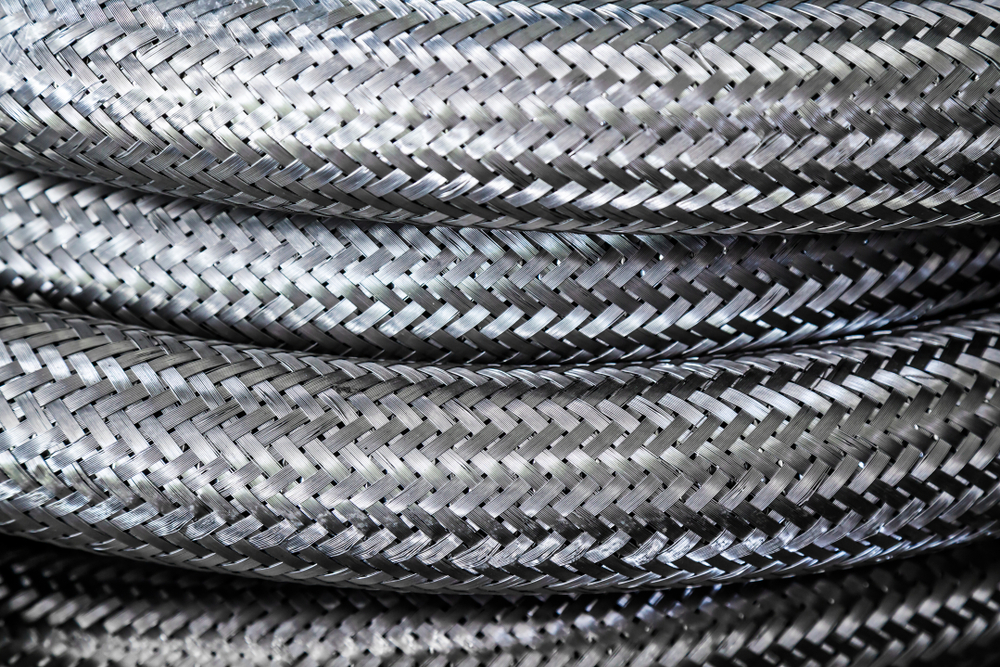
Reinforcement in Hydraulic Hoses
Hydraulic systems rely on high-pressure fluid transmission, making the quality and strength of hydraulic hoses a critical factor in ensuring the efficiency, safety, and durability of these systems. One of the essential aspects of hydraulic hoses is the reinforcement within the hose construction. Reinforced hoses, or reinforced tubing, are specially designed to withstand the high pressure and demanding conditions of hydraulic applications. This blog will dive into the importance of reinforcement in hydraulic hoses, the types of reinforcements used, and how they contribute to the overall performance of hydraulic systems.
The Role of Reinforcement in Hydraulic Hoses
Hydraulic hoses operate under significant pressure, carrying pressurized fluid to various parts of a hydraulic system. Without adequate reinforcement, hoses can rupture, fail, or become deformed, leading to system breakdowns, fluid leakage, and potential hazards. The reinforcement in hydraulic hoses serves as the backbone of the hose’s construction, providing the strength and flexibility necessary to handle these challenging conditions.
The primary function of reinforced tubing is to increase the hose’s resistance to pressure, impact, and temperature fluctuations. The reinforcement layers are strategically designed to enhance the hose’s performance in a variety of industries, from construction to agriculture, manufacturing, and more. By reinforcing the hose, manufacturers can ensure that it can handle the extreme stress and pressure encountered in hydraulic systems, reducing the likelihood of failure and enhancing the lifespan of the hose.
Types of Reinforcement in Hydraulic Hoses
Hydraulic hoses come in various designs and materials, and the reinforcement used depends on the specific requirements of the hydraulic system. Some of the most common types of reinforcement include steel wire, textile braids, and spiral wound wire.
Steel Wire Reinforced Hoses
Steel wire reinforcement is one of the most common and effective methods of reinforcing hydraulic hoses. The steel wire is wound tightly around the core of the hose, providing strength and durability to handle high-pressure environments. Steel wire reinforced hoses are designed to be used in applications where high strength is required, and they are typically capable of withstanding pressures up to 6,000 psi or higher.
These hoses are ideal for heavy-duty applications in industries such as construction, mining, and oil and gas. Steel wire provides high tensile strength, ensuring that the hose maintains its shape under pressure and prevents it from expanding or rupturing. Additionally, steel wire reinforced hoses are resistant to abrasion and can handle exposure to harsh environments, making them highly versatile and reliable.
Textile Braided Reinforcement
Textile braids, usually made from synthetic materials such as polyester or nylon, are another popular option for reinforcing hydraulic hoses. Unlike steel wire reinforcement, textile braids are flexible and lightweight, making them suitable for applications where flexibility and ease of handling are essential. Textile braided hoses are commonly used in lower-pressure hydraulic systems, where flexibility is required, such as in agricultural or automotive applications.
The textile braid provides the hose with additional strength and protection against external damage, such as cuts, abrasions, and environmental factors like UV radiation. The combination of textile braiding and the inner rubber lining ensures that the hose remains intact even under moderate pressure, maintaining the fluid’s integrity and preventing leaks.
Spiral Wound Wire Reinforced Hoses
Spiral wound wire reinforced hoses offer even higher levels of strength and flexibility compared to steel wire and textile braided options. In these hoses, wire is wound in a spiral configuration around the core of the hose. This configuration increases the hose’s resistance to pressure, making it suitable for applications involving very high-pressure environments.
Spiral wound wire reinforced hoses are commonly used in industries where pressures can exceed 10,000 psi, such as in high-performance hydraulic machinery and systems that demand maximum strength and reliability. These hoses are designed to maintain their form and function even under extreme conditions, making them a top choice for the most demanding applications.
Benefits of Reinforced Hoses
The reinforcement within hydraulic hoses offers numerous advantages that contribute to the overall functionality and longevity of hydraulic systems.
Enhanced Pressure Resistance
The primary benefit of reinforcement in hydraulic hoses is the increased ability to withstand high-pressure conditions. Hydraulic systems operate at varying pressure levels, and reinforced hoses are designed to endure these pressures without failure. This allows the hose to function smoothly without leaks, ensuring the hydraulic system operates optimally.
Without proper reinforcement, hoses can expand, burst, or develop leaks under pressure, leading to significant operational disruptions. By using reinforced tubing, hydraulic systems can avoid costly repairs, downtime, and even safety hazards that may arise from hose failures.
Improved Durability
Reinforced hoses are significantly more durable than standard hoses, especially when exposed to harsh environments. The reinforcement layers protect the hose from wear and tear caused by external forces, such as abrasion, chemicals, oils, and extreme temperatures. The result is a longer service life for the hose, reducing the need for frequent replacements and lowering overall maintenance costs.
For example, steel wire reinforced hoses are resistant to abrasions and offer high tensile strength, making them well-suited for rugged environments where mechanical damage is a concern. Similarly, textile braided hoses are resistant to environmental elements, including UV radiation and moisture, helping to preserve the hose’s integrity in outdoor applications.
Flexibility and Ease of Handling
While strength and durability are essential, flexibility is also a key factor in many hydraulic applications. Reinforced hoses are designed to maintain flexibility without compromising on strength, allowing them to be bent and maneuvered easily. This flexibility is critical in applications where space constraints or tight corners make rigid hoses impractical.
Textile braided reinforced hoses, in particular, offer superior flexibility compared to steel wire reinforced hoses. This makes them ideal for applications in automotive or agricultural machinery, where hoses need to be routed through complex systems or confined spaces. Reinforced hoses with textile braids can bend and twist without kinking or cracking, ensuring that fluid flow remains uninterrupted.
Safety and Leak Prevention
Leaks in hydraulic systems can pose serious risks, including fluid loss, damage to machinery, and potential environmental hazards. Reinforced hoses are designed to minimize the likelihood of leaks, ensuring that fluid remains contained within the system. The strength provided by the reinforcement layers prevents the hose from expanding or rupturing, which are common causes of leaks in hydraulic systems.
Steel wire reinforcement, for instance, provides excellent structural integrity, reducing the risk of damage due to pressure surges or external impacts. This enhances the safety of the entire hydraulic system and ensures that it operates in compliance with safety standards and regulations.
Choosing the Right Reinforced Hose
Selecting the right reinforced hose for a specific hydraulic application depends on various factors, such as pressure requirements, environmental conditions, and flexibility needs. It’s important to consider the following when choosing a reinforced hose:
- Pressure Rating: Ensure that the hose is rated for the pressure levels in your hydraulic system. Steel wire reinforced hoses are ideal for high-pressure applications, while textile braided hoses may be better suited for lower-pressure systems.
- Material Compatibility: The materials used in the hose should be compatible with the fluid being transported. Consider the chemical properties of the fluid to ensure the hose won’t degrade over time.
- Environmental Conditions: Take into account factors such as temperature, humidity, and exposure to UV radiation. Hoses used outdoors or in harsh environments may need additional protection against these elements.
- Flexibility and Handling: If the hose needs to navigate tight spaces or be flexible for easier installation, consider a textile braided hose or a hose with spiral wound reinforcement for added flexibility.
Conclusion
Reinforced hoses play an essential role in the performance and reliability of hydraulic systems. The reinforcement enhances the strength, flexibility, and durability of the hose, enabling it to withstand high-pressure conditions, environmental stressors, and mechanical damage. Whether you’re using steel wire reinforced hoses for heavy-duty applications or textile braided hoses for more flexible systems, selecting the right reinforced tubing ensures optimal performance and safety in your hydraulic operations.
Understanding the different types of reinforcement materials and their applications is crucial when selecting hydraulic hoses for specific needs. With the right choice of reinforced hose, you can significantly improve the longevity and efficiency of your hydraulic systems, ensuring they perform reliably and safely for years to come.
Royal Brass Incorporated
Welcome Royal Brass Incorporated! We are your 3rd generation, family-owned, local hose supplier! Our family has dedicated our services to supplying northern California with all types of hoses, fittings, flanges, regulators, valves, adapters, and gauges. We pride ourselves on having the most extensive inventory in northern California. Our inventory ensures that we can fix most products on site, the same day. Here at Royal Brass Incorporated, we only hire qualified individuals who are trained in factory sales. Our fully stocked warehouses ensure that we can fill your hydraulic and pneumatic hose, tubing, and fitting needs on time, every time. High-quality customer service is our goal and has been since 1952. Stop by or contact us today!
Categorised in: Hydraulic Hose





